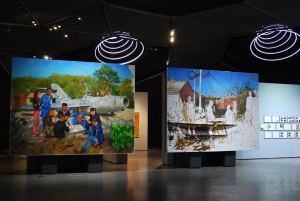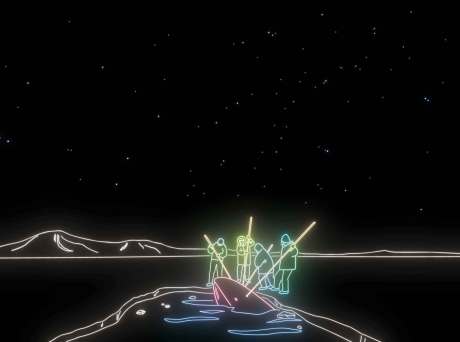After a month in the desolate mining town of Eisenerz, Austria, Liu Xiaodong opened his new exhibition “The Process of Painting” at Kunsthaus Graz. Although I was slightly bewildered by the two new paintings’ setting, the exhibition quite accurately depicts Liu Xiaodong’s process of painting through painting, diary and film. Having accompanied Liu for the duration of the Austrian project, I became accustomed to seeing the paintings in their sheds en situ, quite literally amongst the overgrown fauna that surrounded a swimming pool, or beside a road in the middle of town. The pristine walls and perfect lighting of the Kunsthaus were unnatural in comparison to the dirty and paint covered floors of the painting shed.
Curated by Gunther Holler-Schuster, “Prozess Malen” brings together Liu Xiaodong’s newest Austria project with Hometown Boy, a series created in conjunction with UCCA in Beijing. Quite like the settings in both Eisenerz and Jincheng, Liu Xiaodong’s hometown, the exhibition’s floor plan is both open, like a large town square showcasing Liu’s larger 3×4 meter paintings as well as narrow, with walls more intimately dispersed to create a feeling of meandering streets, and showcasing smaller works from Hometown Boy. Further, there are a total of eight documentary films being screened at various points throughout the exhibition enabling audiences to gain a well-rounded perspective of Liu’s painting process from various projects, as well as spend upwards of six hours (if desired) to absorb the development and evolution of his method. Nevertheless, for those who prefer text, there was hardly a shortage of that as well. Incorporating all 116 pages of his diary from Hometown Boy as well as the 32 from Eisenerz, there was a plethora of emotions, anecdotical tales and photos to captivate readers for several hours.
Peter Pakesch (Kunsthaus Director), Liu Xiaodong, Gunther Holler-Schuster (Exhibition Curator)
Liu Xiaodong (far right) with four students that modeled for the painting in background



















